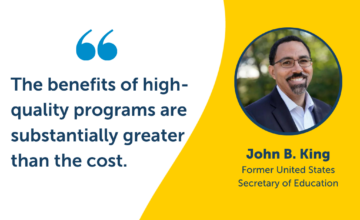I challenge our readers to take a bold step and add intentionality to your efforts to create an organization of inclusion where diverse cultural voices create innovation and where there is a safe space for diverse viewpoints that are respected, understood, and taken into account.
Organizations that seek to transform children’s lives and chart a healthy course of their future are invariably engaging the community at-large—professionals who work with babies and families, policymakers, funders—and as such, it is of paramount importance to place cultural value on diversity and honor the similarities under our surface differences if the prize is to unleash the benefits of our work for our youngest global citizens.
The challenge within organizations is not limited to hiring a diverse workforce, creating culturally responsive principles to reflect our respect for diversity, or changing attitudes toward diversity. Rather, the challenge is to change the organizational culture itself to leverage the potential of the pool of experience and knowledge of its diverse workforce. An example of this culture shift is when organizations are inclusive of their diverse workforce to search for innovative solutions to a problem or to generate product ideas at the first step in product development. An inclusive environment fosters a sense of a shared voice and encourages individuals to stay engaged, innovate, and perform at their highest potential. Ultimately, breaking down cultural silos contributes to the health of the organization but not before all in the organization are made aware that multiple voices, perspectives, and languages are valued and are an organizational priority demonstrated by intentional action.
Cultural sensitivity trainings claim to help the workforce become more “aware” or “learned” about other cultures and teach how to assess other cultures. The outcome of such training, albeit well-meaning, is “otherizing”, the “us vs. them” effect, the implicit denial of interconnectedness that creates a false understanding of people and leaves out the relational aspect of cultural sensitivity. At the organizational level, the process of developing cultural sensitivity starts with how we relate to each other in the workplace, how we respond to other people while taking ownership of and responsibility for our own behavior. As obvious as this may sound, relationship-building is at the core of cultural sensitivity. How you are is as important as what you do (Jeree Pawl).
In principle, most of us agree that in order to create an inclusive and culturally sensitive organization, there is a great amount of awareness and self-reflection needed. A just and equitable society for each and every child starts with us and within us. Hence, I challenge our readers to take a bold step and add intentionality to your efforts to create an organization of inclusion where diverse cultural voices create innovation and where there is a safe space for diverse viewpoints that are respected, understood, and taken into account. The millions of our youngest global children will be grateful you did.
For a thought-provoking perspective, watch this powerful TED Talk where Novelist Chimamanda Adichie “tells the story of how she found her authentic cultural voice—and warns that if we hear only a single story about another person or country, we risk a critical misunderstanding.”



